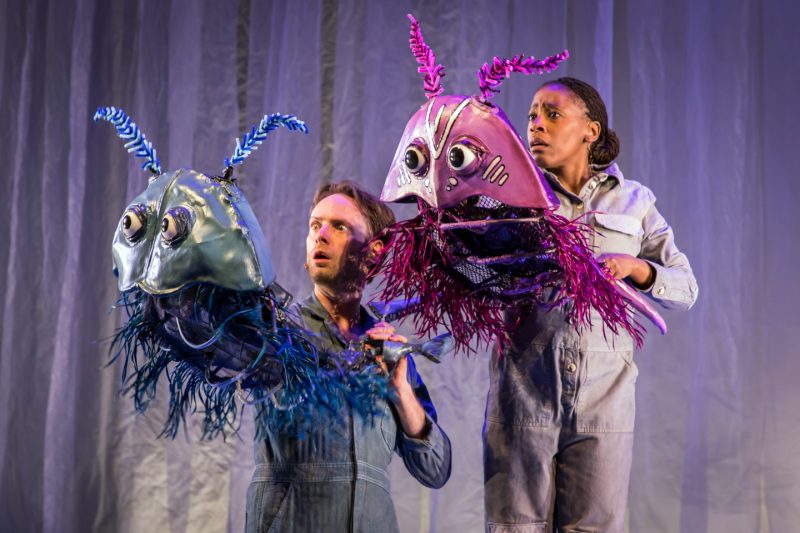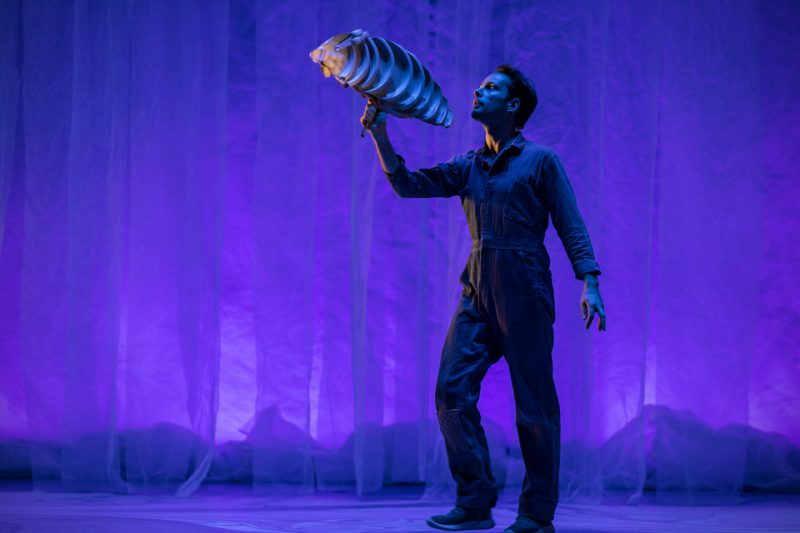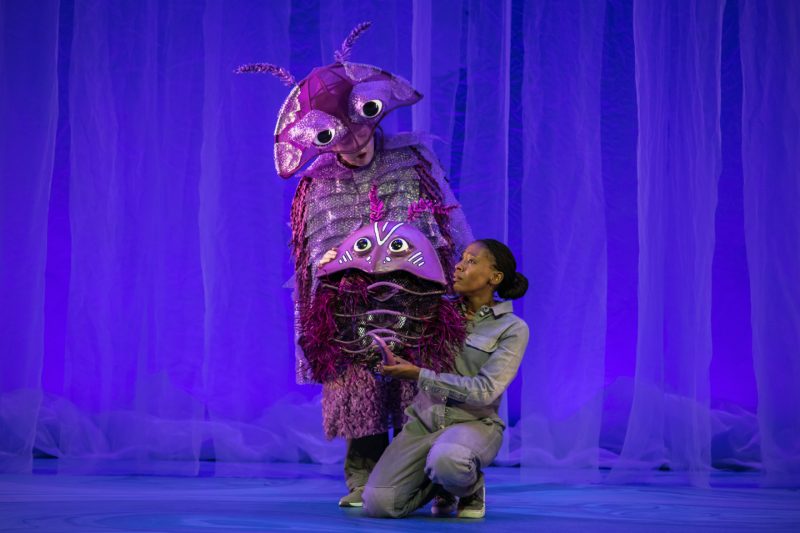RIDDLE OF THE TRILOBITES, created by CollaborationTown and developed as part of New Victory LabWorks, is currently running off-Broadway until February 23.
TYA/USA spoke with playwright and co-creator Jordan Seavey to discuss the development of the piece, creating work for young audiences, and the importance of telling new stories.
In Conversation With

Jordan Seavey
Co-Artistic Director, CollaborationTown
JORDAN SEAVEY’s plays include Homos, or Everyone in America (OBIE Award for performance, Michael Urie; New York Magazine’s 10 Best Theater Events of 2016), The Seven Year Disappear, Wight, November 4th 2008, The Funny Pain, The Truth Will Out, Children at Play, 6969 and This is a Newspaper. Since 2003 he’s co-created more than fifteen new plays with theater company CollaborationTown. He is a Usual Suspect at New York Theatre Workshop, and an alum of The Public Theater’s Emerging Writer’s Group, Primary Stages’ Dorothy Strelsin New American Writers Group, and the Soho Rep Writer/Director Lab.
CollaborationTown creates ensemble-driven, humorous, and heartfelt new plays that defy expectations of how stories can be told in the theater, since 2003. Select productions include: Family Play (1979 to Present) (one of The Advocate’s 10 Best LGBT Plays of 2014), The Deepest Play Ever: The Catharsis of Pathos (The New Ohio Theater), The Play About My Dad (59E59 Theaters), The Momentum (2012 GLAAD Media Award nomination), Children at Play (The Living Theater) and 6969 (59E59 Theaters; winner of three NYIT Awards), Townville, The Astronomer’s Triangle, The Trading Floor. Awarded an Otto Rene Castillo Award for Political Theatre in 2014. Most recently the company devised a new play, Candy, under commission from LCT3 / Lincoln Center. www.collaborationtown.org
How did RIDDLE OF THE TRILOBITES come to be? How has the piece evolved over the course of its development?
-

The inception of RIDDLE OF THE TRILOBITES had all to do with TYA/USA’s own Jonathan Shmidt Chapman, who was working at The New Victory Theater in 2014 and recommended CollaborationTown apply to New Victory’s LabWorks program. New Victory of course presents theater for all ages from all over the world, but prior to LabWorks had little-to-no direct hand in developing such work from the seed phase. LabWorks was formed to encourage more TYA from American artists, and from NYC theater companies, and from companies which might be suited to making work for all ages but did not have a history of doing so. Jonathan thought CTown might be a perfect candidate and we’re glad he did. We applied and were accepted into the program.
CTown is composed mainly of science nerds who wanted to be marine biologists before falling for theater (personally I spent my most fun childhood days collecting fossils on annual vacations with my dad)—and at the beginning of our residency Lee found an article in The New York Times entitled When Trilobites Ruled the World, about how trilobites were once the world’s dominant species and how the planet’s conditions they went extinct under mirrored our current conditions. Of course, we’re also all obsessed by the climate crisis, and wanted to make a piece that is really about something crucially important, right now, so this story grabbed us. We applied with composer Nicholas Williams and knew we wanted to make something with music. Puppet designer Amanda Villalobos came on board pretty early too, because trilobites are so non-human in form. And the combo of trilobites and musical theater just sort of made funny sense with our sensibility. The piece has evolved a great deal over five years—but simultaneously, I realize a lot of the big bones of the piece actually haven’t changed. From day one we knew we wanted a female protagonist and decided very early on to loosely adapt Joseph Campbell’s ‘hero’s journey’ structural model for our heroine’s through-line; this has been a mainstay from the beginning till now. It’s a ‘formula’ we’ve often out-right avoided, or attempted to subvert; since this piece was for ages 6 and up we decided to embrace and commit to it, albeit while making it very much our own. The script development has been extremely ongoing—musicals are super hard to write, and write well. Figuring out puppetry’s role in the play was a huge challenge and took us a long time; the puppets’ design and use in the show has gone through many iterations. I would say the biggest evolution happened between its last semi-staged workshop at New Victory, and its premiere production at Flint Repertory Theater; we learned so much from the former and then, by necessity, had to dive in head-first and commit to hard choices during the latter.

RIDDLE OF THE TRILOBITES. Photo Credit: Cameron Blaylock
Why is this piece being presented for young audiences? What do you think it has to say to young people today?
-

With this piece we are trying hard not to talk down to or condescend to young people (while still being fun, funny, sometimes even silly) on a topic which is unfortunately more timely than ever—the state of our planet. It’s a topic that is scary—to adults as well as kids—and difficult to acknowledge, much less discuss in detail. The piece takes a view that, while our current climate change is particularly tragic due to humans’ involvement in causing it, humans are part of a bigger, billions-of-years-long natural history of the planet Earth, and the current mass extinction the natural world is experiencing has happened before. Five times! I for one was never taught that in school and if I had been I think such context would make this cycle more understandable and less flat-out frightening.
Someone recently said we “predicted” Greta Thunberg before she was Greta Thunberg, which is such a funny and spot-on compliment. It makes so much sense that our protagonist is a young person who finds her anger—particularly at her elders, who refuse to recognize or do anything about the ocean changing around them. Revolutions often start with a youth uprising, and hopefully we’re seeing something akin to that with someone like Ms. Thunberg saying “Stop the world, it’s not enough to just talk – we actually can’t proceed with life until politicians, etc., actually take action!”
It makes so much sense that our protagonist is a young person who finds her anger—particularly at her elders, who refuse to recognize or do anything about the ocean changing around them.
— Jordan Seavey
How has the use of puppetry informed the way the story is told?
-

The puppetry in this show is used in a pretty unusual, sort of ‘hybrid’ fashion. The show is 75 minutes, fully a musical, jumps location from scene to scene, and is performed on an almost entirely bare stage. For these reasons the text and music does most of both the scene-setting and storytelling. Also worth noting, we produced this show on a shoestring budget which restricted – mostly in positive ways—how many and what kind of puppets we used. For all these reasons we needed in our four main characters to be versatile, hand-held, three-dimensional puppets that kind of meld with the actors holding them. We found this through a mix of our director’s staging and directorial brilliance, our puppet designer’s and puppet director’s guidance and in-put, the gung-ho willingness of our talented actors to experiment fearlessly, and by trying it all out over and over again.

RIDDLE OF THE TRILOBITES. Photo Credit: Cameron Blaylock.
Why do you think it is important to share new stories with young audiences and expand the canon of TYA in the US beyond recognizable titles?
-

It’s so important because new stories change minds and hearts – especially young ones – and few forms do so as well or as uniquely as theater. And, all due respect to major IP and famous titles, but those can’t be the only stories young people learn, because in fact the most important “risky” themes and marginalized views are often left out of them completely. As outsiders, or I suppose newcomers, to the TYA world, we’ve been really surprised by the stigma we’ve sometimes felt towards, and the lack of financial support for, work for young / all-ages audiences. And that goes tenfold for work *not* adapted from existing IP. Agents and such have specifically told us they do not understand the market for such work. Stories are how young people learn how to decipher and move through the world! And they can be fun and marketable—even without being based on famous books—even tackling topics as daunting as climate change. We believe this. We have faith!
Stories are how young people learn how to decipher and move through the world! And they can be fun and marketable—even without being based on famous books—even tackling topics as daunting as climate change. We believe this.
— Jordan Seavey
Why do you think it is important for companies like CollaborationTown that mainly serve adult audiences to expand their programming to include children and families as well?
-

Personally—selfishly!—I have found it so challenging and so rewarding to step outside my comfort zone and tell a story for all-ages. So that’s one reason for any individual artist to take that plunge; really, it has made me a better, more careful storyteller I think. But more to the point, it’s so incredible to expose children to art and theater – it expands their minds and opens their hearts to different ways of thinking and expressing themselves, and different ways of receiving information and others’ ways of expressing themselves.

RIDDLE OF THE TRILOBITES. Photo Credit: Cameron Blaylock.
What do you hope is the next step for RIDDLE after its New York premiere?
-

It would be so cool if it could be toured and/or produced in communities all around the country which are not NYC (though we love our hometown!). And, we feel it could be particularly amazing as an animated feature film, which would be seen by even wider audiences, and fulfill our many fantasies of a magically visual underwater world filled with thousands of prehistoric creatures. Nothing beats live theater, but animation would allow this story to be fleshed out in a totally different and equally exciting visual way.


